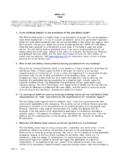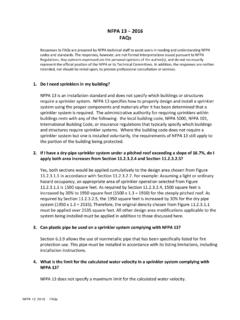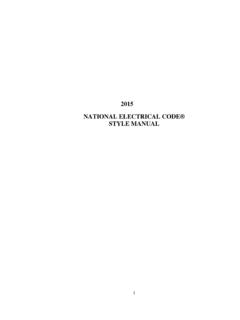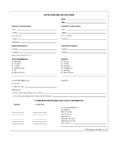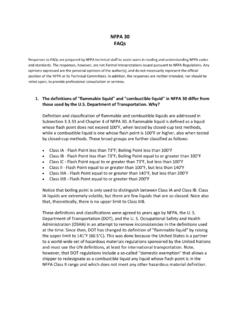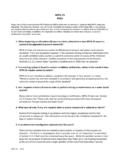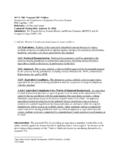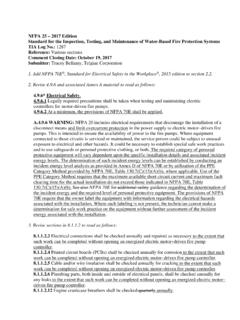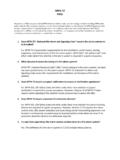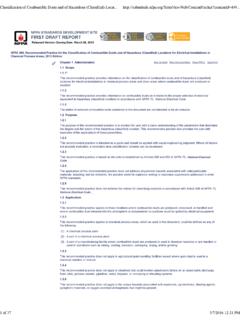Transcription of Chapter 3 Definitions - NFPA
1 Chapter 3 Definitions General. The Definitions contained in this Chapter shall apply to the terms used in this Code. Where terms are not defined in this Chapter or within another Chapter , they shall be defined using their ordinarily accepted meanings within the context in which they are used. Merriam-Webster's Collegiate Dictionary, 11th edition, shall be the source for the ordinarily accepted meaning. nfpa Official Definitions . * Approved. Acceptable to the AHJ. * Authority Having Jurisdiction (AHJ). An organization, office, or individual responsible for enforcing the requirements of a code or standard, or for approving equipment, materials, an installation, or a procedure. * Code. A standard that is an extensive compilation of provisions covering broad subject matter or that is suitable for adoption into law independently of other codes and standards.
2 Guide. A document that is advisory or informative in nature and that contains only nonmandatory provisions. A guide may contain mandatory statements such as when a guide can be used, but the document as a whole is not suitable for adoption into law. Labeled. Equipment or materials to which has been attached a label, symbol, or other identifying mark of an organization that is acceptable to the AHJ and concerned with product evaluation, that maintains periodic inspection of production of labeled equipment or materials, and by whose labeling the manufacturer indicates compliance with appropriate standards or performance in a specified manner. * Listed. Equipment, materials, or services included in a list published by an organization that is acceptable to the AHJ and concerned with evaluation of products or services, that maintains periodic inspection of production of listed equipment or materials or periodic evaluation of services, and whose listing states that either the equipment, material, or service meets appropriate designated standards or has been tested and found suitable for a specified purpose.
3 Recommended Practice. A document that is similar in content and structure to a code or standard but that contains only nonmandatory provisions using the word should to indicate recommendations in the body of the text. Shall. Indicates a mandatory requirement. Should. Indicates a recommendation or that which is advised but not required. Standard. A document, the main text of which contains only mandatory provisions using the word shall to indicate requirements and which is in a form generally suitable for mandatory reference by another standard or code or for adoption into law. Nonmandatory provisions shall be located in an appendix or annex, footnote, or fine-print note and are not to be considered a part of the requirements of a standard.
4 General Definitions . * Absolute Pressure. Pressure based on a zero reference point, the perfect vacuum. [55, 20132016] Access Box. An approved secure box, accessible by the AHJ's master key or control, containing entrance keys or other devices to gain access to a structure or area. Addition. An increase in building area, aggregate floor area, building height or number of stories of a structure. [5000, 2015] * Aerosol Product. A combination of a container, a propellant, and a material that is dispensed. [30B, 2015] Airport (Aerodrome). An area on land or water that is used or intended to be used for the landing and takeoff of aircraft and includes buildings and facilities. [402, 2013] Airport Ramp.
5 Any outdoor area, including aprons and hardstands, where aircraft can be positioned, stored, serviced, or maintained, irrespective of the nature of the surface of the area. [415, 20132016] * Aisle Width. The horizontal dimension between the face of the loads in racks under consideration. [13, 20132016] Alarm. A warning of danger. [72, 2013]. An indication of the existence of a condition that requires immediate response. [72, 2016] Alarm Signal. See Alcohol-Based Hand Rub. An alcohol-containing preparation designed for application to the hands for reducing the number of visible microorganisms on the hands and containing ethanol or isopropanol in an amount not exceeding 95 percent by volume.
6 Alleyway. An accessible clear space between storage piles or groups of piles suitable for housekeeping operations, visual inspection of piling areas, and initial fire-fighting operations. Alternative. A system, condition, arrangement, material, or equipment submitted to the AHJ as a substitute for a requirement in a standard. [1144, 2013] ANSI/ASME. The designation for American National Standards Institute publication sponsored and published by the American Society of Mechanical Engineers. Area. Back Stock Area. The area of a mercantile occupancy that is physically separated from the sales area and not intended to be accessible to the public. [30B, 2015] Control Area. A building or portion of a building or outdoor area within which hazardous materials are allowed to be stored, dispensed, used, or handled in quantities not exceeding the maximum allowable quantities (MAQ).
7 [400, 20132016] Fire Area. An area of a building separated from the remainder of the building by construction having a fire resistance of at least 1 hour and having all communicating openings properly protected by an assembly having a fire resistance rating of at least 1 hour. [30, 2015] Fire Flow Area. The floor area, in square feet, used to determine the required fire flow. Indoor Area. An area that is within a building or structure having overhead cover, other than a structure qualifying as weather protection in accordance with Section of nfpa 55, Compressed Gases and Cryogenic Fluids Code. [55, 20132016] Inside Liquid Storage Area. A room or building used for the storage of liquids in containers or portable tanks, separated from other types of occupancies.
8 [30, 2015] Organic Peroxide Storage Area. An area used for the storage of organic peroxide formulations. [400, 20132016] Outdoor Area. An area that is not an indoor area. [55, 20132016] Permissible Areas. Designated Area. A specific location designed and approved for hot work operations that is maintained fire safe such as a maintenance shop or a detached outside location that is of noncombustible or fire-resistive construction, essentially free of combustible and flammable contents, and suitably segregated from adjacent areas. [51B, 2014] Permit-Required Area. Any location other than a designated area that is approved for hot work. A permit-required area is an area that is made fire safe by removing or protecting combustibles from ignition sources.
9 [51B, 2014] Sales Display Area. The area of a mercantile occupancy that is open to the public for the purpose of viewing and purchasing goods, wares, and merchandise. Individuals are free to circulate among the items, which are typically displayed on shelves, on racks, or on the floor. [30B, 2015] Smoking Area. A designated area where smoking is permitted within a premises in which smoking is otherwise generally prohibited. * Spray Area. Any fully enclosed, partly enclosed, or unenclosed area in which dangerous quantities of flammable or combustible vapors, mists, residues, dusts, or deposits are present due to the operation of spray processes, including (1) any area in the direct path of a spray application process; (2) the interior of a spray booth or ,, spray room, or limited finishing workstation, as herein defined; (3) the interior of any exhaust plenum, eliminator section, or scrubber section; (4) the interior of any exhaust duct or exhaust stack leading from a spray application process; (5) the interior of any air recirculation filter house or enclosure,path up to and including secondary recirculation particulate filters.
10 (6) any solvent concentrator (pollution abatement) unit or solvent recovery (distillation) unit; and (7) the inside of a membrane enclosure. The following shall not be considered are not part of the spray area: (1) Ffresh air make-up units; (2) Aair supply ducts and air supply plenums; (3) Rrecirculation air supply ducts downstream of secondary recirculation particulate filters; and (4) Eexhaust ducts from solvent concentrator (pollution abatement) units. [33, 20112016] ASME. American Society of Mechanical Engineers. [58, 2014] ASME Container (or Tank). See ASTM. American Society for Testing and Materials, now known as ASTM International. [55, 20132016] Automatic Emergency Shutoff Valve.
